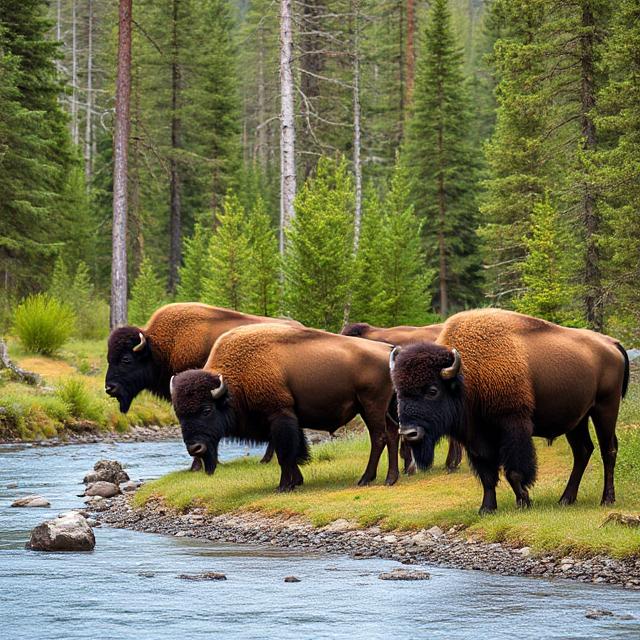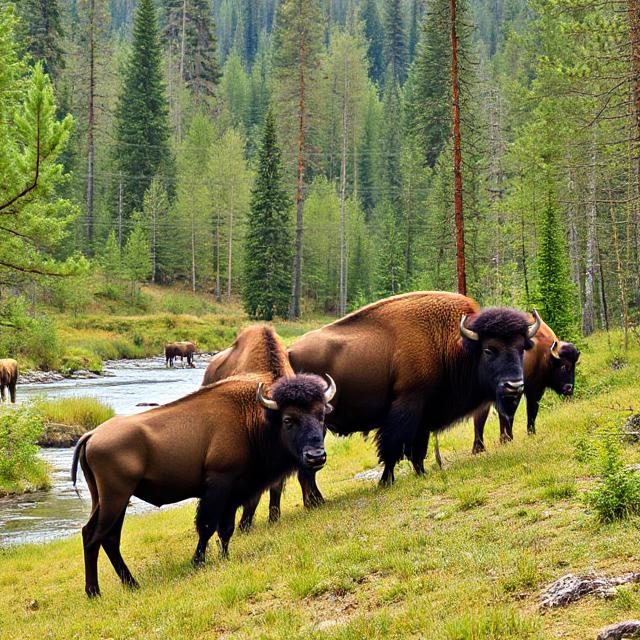🧬 General Overview
The American Bison, also commonly referred to as the American Buffalo, is the largest land mammal in North America. Once roaming in massive herds across the Great Plains, their population declined drastically due to overhunting in the 19th century but has since recovered in protected areas.

🔬 Classification
- Kingdom: Animalia
- Phylum: Chordata
- Class: Mammalia
- Order: Artiodactyla
- Family: Bovidae
- Genus: Bison
- Species: Bison bison
There are two subspecies:
- Plains Bison (Bison bison bison)
- Wood Bison (Bison bison athabascae) – larger and found in Canada and Alaska
🐃 Physical Characteristics
- Size: Males up to 6.5 feet tall at the shoulder; females smaller
- Weight: Males: 1,000–2,200 lbs; Females: 800–1,200 lbs
- Color: Dark brown, with a shaggy mane and beard
- Horns: Both males and females have short, curved horns
- Notable Features: Large hump over the shoulders (muscle mass for plowing snow), thick fur for insulation in cold weather
🌎 Habitat
- Historic Range: Grasslands, prairies, plains, and river valleys of North America, from Canada to Mexico
- Current Range: Mostly in national parks, reserves, and private lands in the U.S. and Canada
- Preferred Habitat: Open plains, meadows, and lightly forested regions
🌿 Diet
- Type: Herbivore (grazing)
- Main Foods: Grasses, sedges, herbs, and shrubs
- Feeding Behavior: Bison graze for 9–11 hours a day, especially in the early morning and late afternoon
🧠 Behavior
- Social Structure: Live in herds (female-led groups with young; males may form bachelor groups)
- Temperament: Generally calm but can be aggressive when threatened
- Migration: Some bison migrate seasonally to find food and avoid harsh weather
- Speed: Can run up to 35–40 mph despite their size
🍼 Reproduction
- Mating Season: July–September (Rut)
- Gestation: About 9.5 months
- Offspring: Typically one calf; twins are rare
- Calves: Born in spring; reddish-orange at birth (“red dogs”)
🛡️ Conservation Status
- IUCN Red List: Near Threatened
- Threats: Habitat loss, genetic bottleneck, interbreeding with cattle
- Recovery Efforts: Reintroduced to many protected areas; managed herds in parks like Yellowstone
- Conservation Success: From <1,000 individuals in the 1800s to over 500,000 today (though most are in commercial herds)

🎉 Fun Facts
- Bison are the national mammal of the United States (designated in 2016).
- Their heads function as snowplows, allowing them to graze through snow in winter.
- Despite their bulk, they can leap over 6-foot fences.
- The American Bison is a keystone species, shaping the ecosystem by grazing patterns and wallowing behavior.
- A bison herd can trample and reshape landscapes, helping to maintain prairie ecosystems.